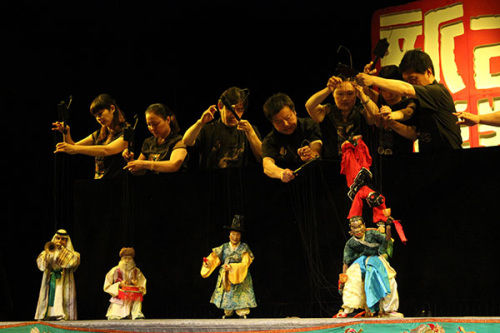
Members of the Quanzhou Marionette Troupe give a performance. The city of Quanzhou in Fujian province is home to traditional Chinese marionette. (Photo by Wang Kaihao/China Daily)
Marionettes have a rich tradition in China, where puppeteers are desperately trying to preserve the art form for future generations.
The 200-year-old yard tucked away in an old neighborhood of Quan-zhou, Fujian province, is more like a temple than a theater.
A statue of the "God of Marionettes" is worshipped in the middle of the hall. After burning incense to pay homage to the deity, performers from the Quanzhou Marionette Troupe begin to practice the complex manipulation of the puppets with their fingers.
Xia Rongfeng has been in the troupe for 32 years. He has only accepted two apprentices.
"Not everyone is talented enough to handle 30 strings at the same time," the stage veteran explains. "I can teach many students, but I am picky when choosing apprentices."
It can take 10 years of training to become a mature marionette practitioner: from the making of puppets to performance and singing.
"One of the most important disciplines is that the puppeteers have to participate in every process of the show," Xia says, clutching his monkey puppet, which has accompanied him for years, and just impressed another audience by riding a bicycle and performing acrobatics.
"Only in that way will they learn to love the puppets like their own children."
When Xia first joined the troupe they only had 10 puppeteers, who were struggling to revive the thousand-year-old tradition in the aftermath of the "cultural revolution" (1966-76). Luckily for locals, marionettes have always been part of their daily life: In Quanzhou, marionettes are ubiquitous at weddings, funerals and other major celebrations and worshipping ceremonies.
For locals, puppets are the "media between humans and heaven."
"The development of the marionette basically has two directions: One is closely connected to religious rituals, and the other was born in the theater," says Wang Jingxian, head of the troupe, a scriptwriter who resigned from his government job in 1992 to promote marionettes. "In Quanzhou, we have both."
Marionettes first appeared in the north of China more than 2,000 years ago, but they traveled to Quanzhou via northern immigrants as late as in the Tang Dynasty (AD 618-907). Today, the city has become the home of traditional Chinese marionette.
"What the inheritors of traditional arts fear most is war," Wang explains. "Continuous wars in northern China during ancient times stopped any chance marionettes had to evolve and develop.
"Though there is some scattered distribution of marionettes in other places in China, Quanzhou is the only place where the tradition has been preserved uninterrupted. Much of the repertoire performed today is from the Southern Song Dynasty (1127-1279)."
Quanzhou Marionette was inscribed in the national intangible cultural heritage list in 2006. It has been shown in more than 60 countries, and its international reach peaked at the opening ceremony of the 2008 Beijing Olympic Games.
















































